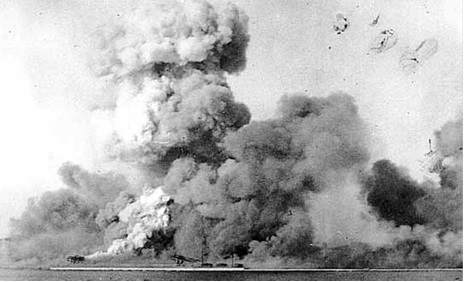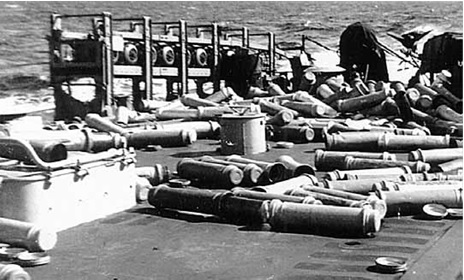The Korean Campaign
Republic of Korea (ROK)
USS MASSEY as a unit of Destroyer Division 162 [ZELLERS (DD 777), SPERRY (DD 697), MASSEY (DD 778) and FORREST ROYAL (DD 872)] left Norfolk, VA on 6 September 1950. One month later the Division was on station and commenced an eight month uninterrupted period of activity.
The MASSEY’s first mission in Korean waters was as flagship for the minesweeping force on the East Coast. For over a month and a half this group swept the Wonsan, Hungnam and Songjin minefields. Personnel from the MASSEY aided in the small boat sweeping of the heavily mined inner harbor of Wonsan. The CIC of MASSEY plotted the mine sweeping runs and controlled the helicopters on anti-mine searches. On 24 November, MASSEY boats freed an Army crane barge from its mooring to a mine-sunken Army tug in the center of the Wonsan minefield and towed it to safety.
In December 1950, the Chinese Communists unleashed their aggression against the United Nations Forces of Korea. Elements of the ROK Capital Division were cut off and forced to evacuate the port of Songjin under cover of the MASSEY’s 5-inch battery, with a total of 470 rounds expended.
The Chinese pressing southward entrapped the US 1st Marine Division near the Chosin Reservoir. The MASSEY joined the firing line as the Marines fought their way free and the Army’s 3rd and 7th Divisions held the beachhead at Hungnam. With the evacuation of Hungnam, Army artillery and the Navy ships in the harbor bombarded the shore. For 11 days and nights, MASSEY’s 5-inch guns fired shells into the advancing enemy. Over the night of 22 December shells from the MASSEY broke up a concentrated attack on one of the Army X Corps units that had been cut off and surrounded. In all 2,663 five-inch shells were fired by the MASSEY and the ship was credited with saving one Army Company. On 24 December with evacuations completed, the MASSEY destroyed the harbor facilities and then withdrew as the first ship in and the last ship out Hungnam inner harbor.

Taken off the USS MASSEY DD778, one of the last ships to leave the harbor.
The cans on the fantail are five-inch powder canisters. 24 December, 1950
In the dark days of late December 1950 and January 1951, the MASSEY participated in blockade and bombardment patrol along the Korean East Coast, denying the enemy the use of the sea and harassing their communications. The MASSEY supported the intense bombardment of Kosong and Kansong, adding 599 more rounds to her credit.
After a tour of duty during February 1951 with the screen of the USS BATAAN (CVL 29) on the West Coast of Korea, the MASSEY returned to Songjin and added her guns to the siege.
During March and April 1951, the MASSEY interdicted and harassed the enemy communication at Wonsan, Songjin, and Chongjin. With 3,874 rounds fired, the enemy was denied use of the coastal highway and railroad. During this same time, the MASSEY sank 10 Russian type mines sown in Korean waters.
During the third week of March, the MASSEY’s guns supported the ROK Capital Division as it pushed across the 38th parallel and recaptured the city of YANG YANG. In all, 1,635 rounds were expended. On the 6th and 7th of April the MASSEY hurled 784 rounds into the beach in support of the Royal Marine Commando raid south of Songjin.
The month of May found the MASSEY screening the carriers, cruisers, and battleship of Task Force 77 of the Korean East Coast. MASSEY with the USS SPERRY (DD 697), led the USS NEW JERSEY (BB 62) into the coastal waters near Kosong for her first fire mission in Korea. While with Task Force 77, the MASSEY sank her 11th mine in Korean waters. The MASSEY fired 10,025 five inch shells into Korean and Chinese aggressors. For her Korean service, the MASSEY received Four Battle Stars to add to the Two Battle Stars from WWII.
On 6 June 1951, the MASSEY sailed from Japan with Destroyer Division 162 without a casualty to personnel or equipment. On 18 June DESDIV 162 and the MASSEY arrived in San Diego, CA. These four ships got a noisy welcome in Norfolk, VA on 2 July 1951. Bands on the pier burst into “Happy Days Are Here Again” and “Anchors Aweigh” while hundreds of sweethearts shouted and waved. Shortly thereafter CDR E.R. King was relieved as CO by CDR H. Kriloff. Edward R. King eventually retired from the Navy with the rank of Rear Admiral.
Note: The historical information provided on this web site is not the official history of the USS MASSEY. It is based in part on the recollection of many authors, some former Commanding Officers, all former MASSEY shipmates, who contributed to developing the chronology of events that marked some of the noteworthy contributions of this fine Man O’ War to our Navy’s history over nearly 30 years of active service.
Just had a chance to read the actions my father was in during the “Korean Police Action.” He never really talked much about it. He was Robert Arnold Sr., 1st Class Boilerman. When he passed away, he was a Sr. Chief in the U.S. Coast Guard.
I served on Massey from 1948-1952, I was in the Supply Dept, left the ship as an SK2. I have many fond memories of my shipmates. I served on three other ships in my 22 year career but Massey was always my favorite.
Joe – I share the same thoughts. Did a few more ship tours but MASSEY always remained a special ship with a special crew vibe that was her legacy. Hope you are considering the next reunion in Norfolk 02-06 Oct 2023. Thanks for contacting us. Be safe. s/Dick Pearsall 64-66
My Grandfather Ernest N Bryant was a fire controlman during this time on the Massey. I have heard many stories about the bombardment of the coast of Korea and his time on the boat. Just took him on an honor flight to D.C about two years ago. Appreciate the service of all the men that fought.
My Grandfather Donald H Biederman was a boilerman on the USS Massey. he passed away on December 25,2012. we Love You Poppy and thank you for your service
I like to think the part I played while serving on the Massey helped to keep her good name. I want to thank ALL that served on her before and after me, good job mates,bless you all. DS
My father, George Coleman, was a gunner on the Massey during the Korean War. He never spoke of his service, and eventually died of cancer. I want to Thank all Veterans for their selfless sacrafice. For the courage you had and the things you did to keep freedom alive. God Bless You all!